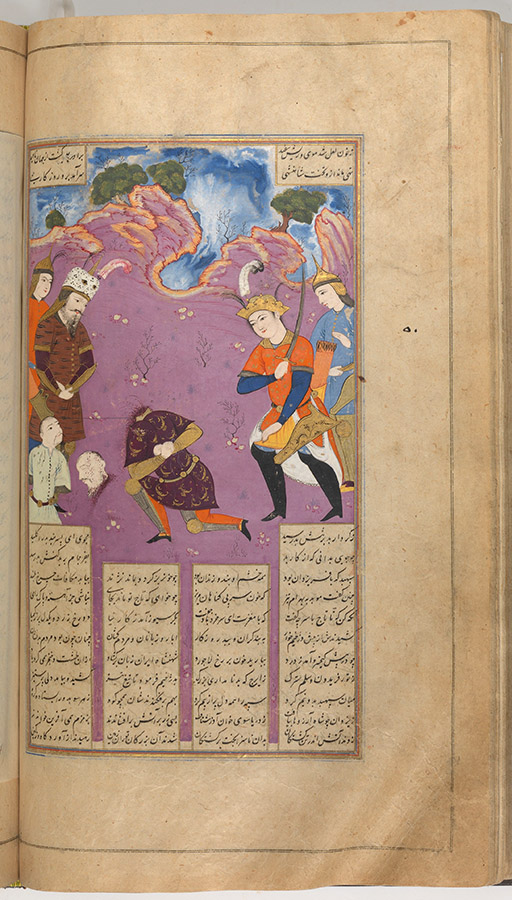Moʿin Moṣavver | Manuscripts | Shahnama of Ferdowsi
Manuscript E, no. 4-268
Kay Ḵosrow Executes Afrāsiyāb
Location: The Metropolitan Museum of Art, New York. Acc. no. 1974.290.43
Page: 36.5 x 22.2 cm.
Painting: 17.4 x 14.3 cm (scaled, max. size without narrow extensions between columns).
Text area: 25.2 x 14.3 cm.
Text: four column; deepest column 13 lines on a 30 line per full page matrix.
Illustration number: The number 50 written in Arabic numerals, presumably of later date, appears in the right margin, probably indicating that it was the fiftieth painting in the manuscript.
The great war between the Iranians and Turānians continued off and on for many years. Finally, when Kay Ḵosrow ascended the throne of Iran, he vowed to finally end the war and avenge all the deceitful deaths he blamed upon his grandfather Afrāsiyāb, king of the Turān. A great battle ensued in which the Iranian forces prevailed. Hum sought out and isolated Afrāsiyāb, lassoed him by the neck, and dragged him through the dust. When Kay Ḵosrow approached him, sword in hand, and vengeance in his eyes, Afrāsiyāb asked why he wished to kill his own grandfather. Ḵosrow responded simply that Afrāsiyāb was evil, and had killed his own brother, Shah Nowzar, and Siyāvoš. With that Kay Ḵosrow swung his sword and lopped off the head of Afrāsiyab.
The painting shows the event just after Kay Ḵosrow has swung his sword; Afrāsiyāb's headless body is still upright in the kneeling position. His severed head is on the ground just to the left. In the far left corner is Garsivaz, Afrāsiyāb's henchman in the killing of Siyāvoš and now captive, who was brought there by his captors to witness the execution. His turn was to be next. On the left, further back in the pictorial space is Rostam, standing calmly with his hands clasped before him. Two other Iranian soldiers, one on the left and one on the right, are also witnesses to the event. The backdrop is the familiar purple hillside that rises to craggy ridge tipped in orange at the top, with a few green bushes and a stormy blue wash sky at the far top.
There are four columns of text above and below the painting. A rectangular ruled frame encloses illustration and text. The painting is not signed or dated.
Painting references:
www.metmuseum.org - search collections for 1974.290.43.
Text references:
Warner, IV, pp.266-69. Mohl IV, pp.166-67
Photo: © The Metropolitan Museum of Art, New York. Bequest of Monroe C. Gutman, 1974.
Robert Eng
Last Updated: June 9, 2013 | Originally published: June 9, 2013
Manuscript E, no. 4-268
Kay Ḵosrow Executes Afrāsiyāb
Location: The Metropolitan Museum of Art, New York. Acc. no. 1974.290.43
Page: 36.5 x 22.2 cm.
Painting: 17.4 x 14.3 cm (scaled, max. size without narrow extensions between columns).
Text area: 25.2 x 14.3 cm.
Text: four column; deepest column 13 lines on a 30 line per full page matrix.
Illustration number: The number 50 written in Arabic numerals, presumably of later date, appears in the right margin, probably indicating that it was the fiftieth painting in the manuscript.
The great war between the Iranians and Turānians continued off and on for many years. Finally, when Kay Ḵosrow ascended the throne of Iran, he vowed to finally end the war and avenge all the deceitful deaths he blamed upon his grandfather Afrāsiyāb, king of the Turān. A great battle ensued in which the Iranian forces prevailed. Hum sought out and isolated Afrāsiyāb, lassoed him by the neck, and dragged him through the dust. When Kay Ḵosrow approached him, sword in hand, and vengeance in his eyes, Afrāsiyāb asked why he wished to kill his own grandfather. Ḵosrow responded simply that Afrāsiyāb was evil, and had killed his own brother, Shah Nowzar, and Siyāvoš. With that Kay Ḵosrow swung his sword and lopped off the head of Afrāsiyab.
The painting shows the event just after Kay Ḵosrow has swung his sword; Afrāsiyāb's headless body is still upright in the kneeling position. His severed head is on the ground just to the left. In the far left corner is Garsivaz, Afrāsiyāb's henchman in the killing of Siyāvoš and now captive, who was brought there by his captors to witness the execution. His turn was to be next. On the left, further back in the pictorial space is Rostam, standing calmly with his hands clasped before him. Two other Iranian soldiers, one on the left and one on the right, are also witnesses to the event. The backdrop is the familiar purple hillside that rises to craggy ridge tipped in orange at the top, with a few green bushes and a stormy blue wash sky at the far top.
There are four columns of text above and below the painting. A rectangular ruled frame encloses illustration and text. The painting is not signed or dated.
Painting references:
www.metmuseum.org - search collections for 1974.290.43.
Text references:
Warner, IV, pp.266-69. Mohl IV, pp.166-67
Photo: © The Metropolitan Museum of Art, New York. Bequest of Monroe C. Gutman, 1974.
Robert Eng
Last Updated: June 9, 2013 | Originally published: June 9, 2013
